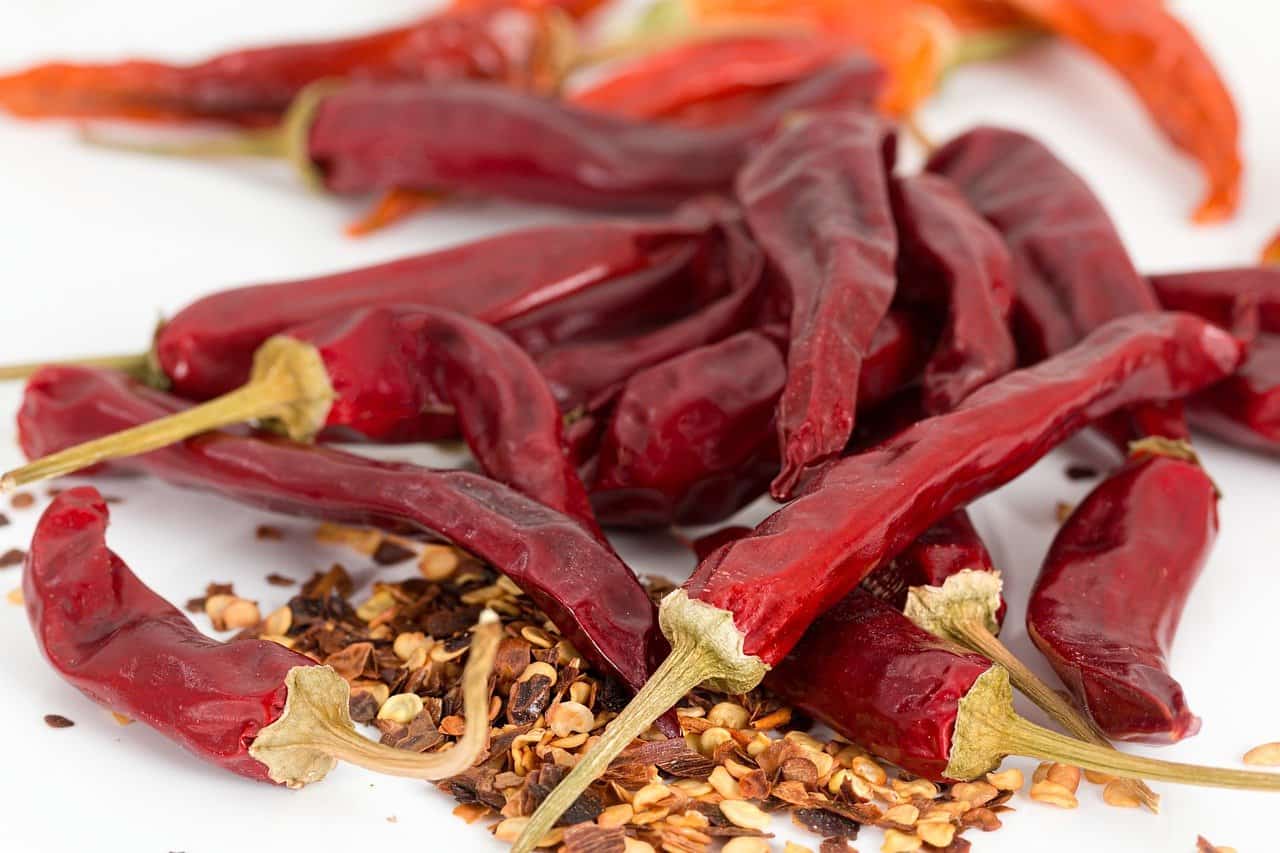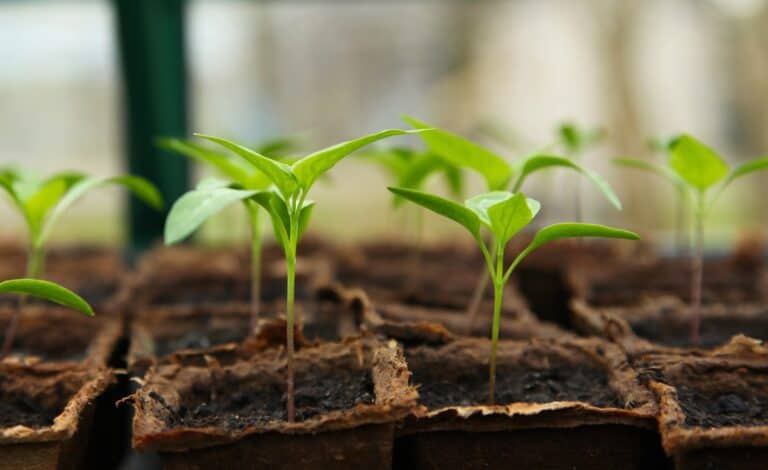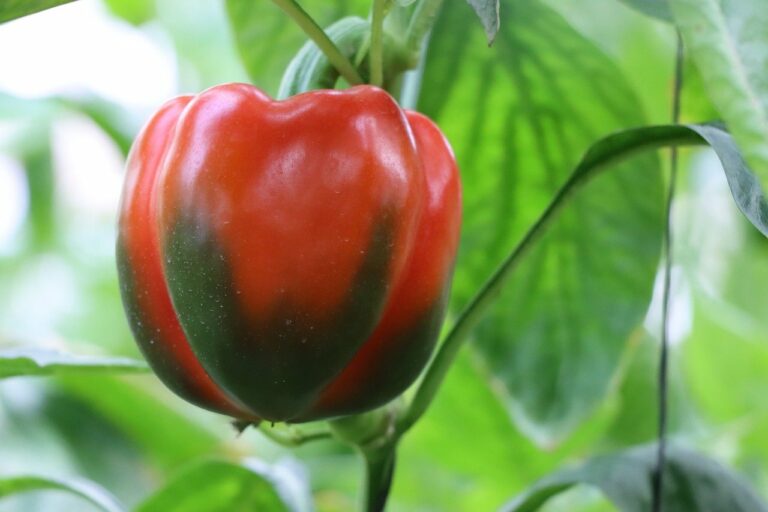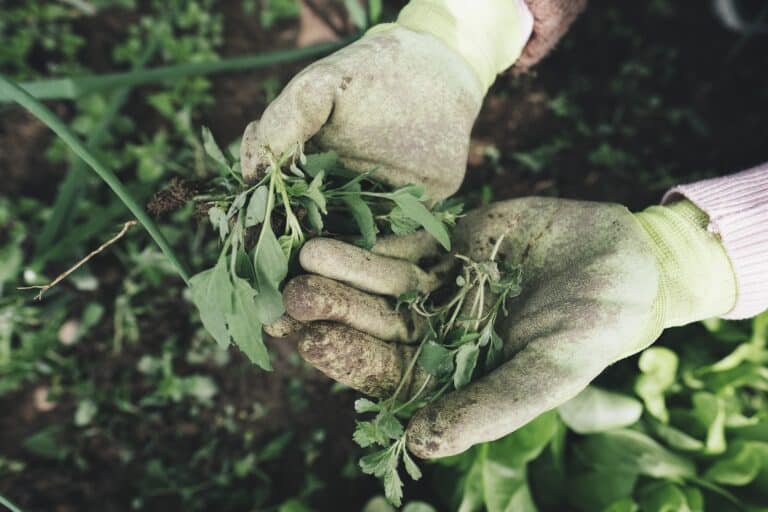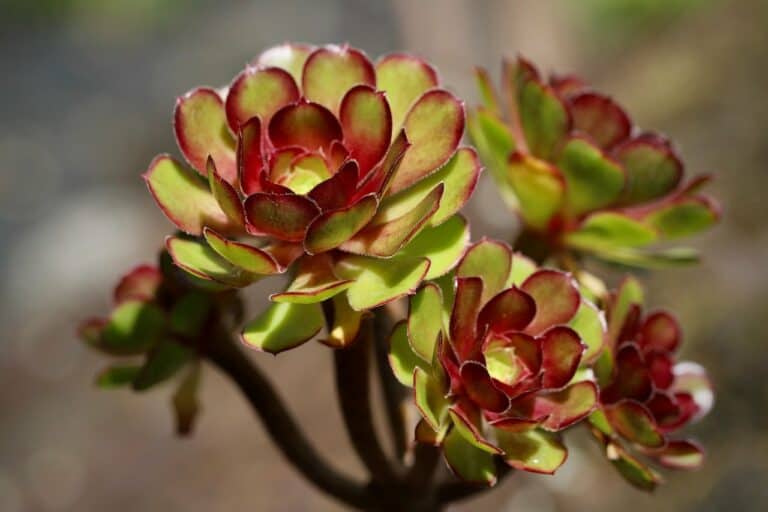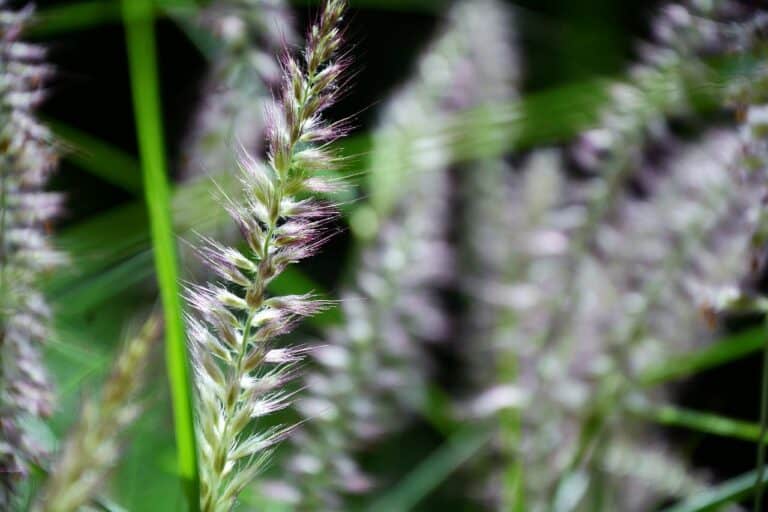Table of Contents
Top 20 Most Common Types of Edible Peppers
SHU = Scoville Heat Units (SHUs)
Whether the recipe calls for spicy chili pepper, sweet bell pepper, or anything in between, peppers are the star ingredients that add flavor to dishes.
Belonging to the Capsicum family, peppers come in various varieties. Other than their different shapes, sizes, and colors, each type has its unique flavor. Some are sweet, while others are spicy and hot.
The primary feature of pepper is its heat, and there there’s even a unit for measuring it called the Scoville heat units (SHU)! At the very bottom of the scale lie the harmless bell peppers with, while at the very top, you the deadliest Carolina Reaper at 1,400,000 to 2,200,000 SHU – never to be eaten raw!
Let’s explore the exciting world of peppers to spice up your everyday recipes with rich flavors. Tangy, sweet, spicy, or a clava variety suit all flavor preferences.
1. Bell Peppers
SHU: 0
Sweet, mild-flavored bell peppers come in a range of bright colors, including green, red, yellow, orange, purple, and brown. If bell pepper is picked in its immature state, it’s green, slightly bitter, and grassier. However, it can turn red, yellow, purple, or a different color when allowed to mature, depending on the variety.
Riped bell peppers have a sweeter taste; bell peppers are great for stuffing because they are larger and milder than other peppers. In addition, they have a high water content, making them perfect for adding moisture and color to dishes.
2. Mini Sweet Pepper
SHU: 0
These varieties are similar in appearance and taste to bell peppers but smaller. Typically, these varieties are slightly sweeter than the regular bell peppers and have fewer seeds to remove from the center. You can stuff them, roast them or sauté them with other fresh vegetables for a colorful side dish.
3. Banana Pepper
SHU: 0 – 500
Banana pepper from the curved shape and the yellowish color, similar to a banana. Also sometimes called yellow wax pepper and banana chili, this variety is tangy, with a mild heat. The mild taste makes it a favorite ingredient in pickles, sandwiches, pizzas, and Greek salads. Also, it is a rich source of vitamin C, making it a healthy component of your everyday diet.
4. Sweet Italian Pepper
SHU: 100 to 500
Also known as pepperoncini, friggitello peppers, or Tuscan peppers, Sweet Italian pepper is native to Italy, as the name suggests. These greenish-yellow peppers are slightly hotter and slightly bitter than bell peppers. The fruit is green when immature but turns red when mature. They are typically picked when still green and immature and used in various dishes, including pizzas and salads; they are also commonly available as pickles in jars and used as a tangy addition to meals.
5. Cherry Peppers
SHU: 100 to 500
Also called pimento or pimiento peppers, cherry peppers are small, round, heart-shaped peppers. They are mildly sweet and spicy, slightly more flavorful than the large red peppers. They have a thicker, juicier wall than the large bell peppers. Pimento peppers are the key ingredients of pimento cheese and are also commonly available pickled in jars. You can stuff them with green olives for a bright side dish to a dinner party or roast them with other vegetables.
6. Shishito Peppers
SHU: 100 to 1000
Also called ground cherry pepper, warm-gothic, and Shishitōgarashi Shishito peppers are East Asian peppers, particularly popular in Japan. Japanese often consume it as an appetizer after frying and drizzling with sesame oil and soya sauce. They are typically picked when immature and green in color.
The variety is thin-walled and has a mild, sweet taste, hinting tanginess—the spiciness of the pepper increases as it gets riper. Shishito peppers are typically served charred or seared, though they can also be eaten raw. They make a flavorful addition to tempura, pizza, and many other dishes.
7. Piquillo Peppers
SHU: 500 to 1000
Typically grown in Spain, piquillo peppers are mildly sweet, with little heat and tanginess. The peppers are 2.5 to 3 inches long, maturing to a bright red shade. With thick, crunchy walls and mild taste, they can be included in various dishes and even consumed raw, similar to bell peppers. They can be pickled, stuffed, roasted, or fried. You can also cook them into soups and sauces. In addition, you’ll often find them pickled and canned or jarred in specialty grocery stores.
8. Paprika Pepper
SHU: 250 to 1000
Paprika is a mild variety of pepper that you often see as a ground spice in grocery stores. It is created into a spice by drying and grinding the fruit. The fruit is a large, cone-shaped pepper that can grow up to 8 inches in length. Since the heat is low, cooks often use it in recipes like deviled eggs and salads to add color. However, it also adds a unique flavor and a boost of Vitamin C to dishes, whether used fresh or as a spice. You will also find smoked paprika spice created by smoking the fruit before grinding them. It brings a more savory, smoky flavor, perfect for barbeque recipes. Interestingly, paprika pepper is also used as a hair dye! It brings a fiery red hue to the hair.
9. Anaheim Chiles
SHU: 500 to 2500
Named after its popularity, Anaheim, California, Anaheim chiles are chili pepper with mild heat and sweetness. Though the variety originated in New Mexico, it was brought and grown commercially in Anaheim, California, in 1894, and it remains popular in the region to this day.
The fruit grows up to 6 to 10 inches in length and is typically picked and consumed while still green and immature, though you can also consume it when it’s fully ripe and red. These are the most common chili peppers available in the United States, adding flavor to various dishes. Anaheim chiles are often confused with Hatch peppers, which are hotter peppers grown in the Hatch region of New Mexico.
10. Hatch Peppers
SHU: 1000 to 8000 (or higher)
Also known as New Mexican peppers, Hatch peppers are given to pepper varieties cultivated in Hatch Valley, New Mexico. There are several varieties of Hatch peppers, including NuMex Big Jim, NuMex Sandia, NuMex R Naky, Barker Extra Hot, and more. They typically have one-third the hotness of regular jalapeno pepper, though some varieties can be just as hot.
Since different types of peppers can be classified under the category of Hatch peppers, the SHU range is quite extensive, where some are much milder than others.
11. Poblano Peppers
SHU: 1000 to 2000
Also called ancho chilis in their dried form, poblano pepper comes from Puebla, Mexico. Poblano peppers are one of the most popular peppers in Mexico. Although they are hot for many people, the variety lies in the mild range of the SHU scale. While they are gentle in their unripe state, poblano peppers turn hotter as they mature. They are great for grilling, roasting, and grinding in mole sauces. Because of their large size, poblano peppers also work great for stuffing. Once they are fully ripe and dried, they are called anchos.
12. Chilaca Peppers
SHU: 1000 to 2500
An essential part of Mexican cuisine, Chilaca pepper is a dark green, mildly hot pepper that grows to around 6 to 9 inches in length. As the pepper matures, it turns a darker black, brown color. Once fully mature and dried, it’s called pasilla pepper or chile negro.
The pepper is rarely used in its fresh form. In dried form, as pasilla pepper, it’s widely used in Mexican cuisine, especially in preparing mole sauces and enchilada sauces. When ground, it can be used as a condiment or table sauce. Fresh chilaca peppers are 2 to 5 times milder than a typical Jalapeno pepper. However, in its dried form, it can be hotter.
13. Jalapenos
SHU: 2500 to 8000
Jalapenos are among the most popular peppers because of their outstanding flavor and availability. On the SHU scale, they lie in the moderate range, with just the right heat level for most people. They are hot but not too hot and include a subtle fruity flavor, making them just perfect for a wide range of dishes, from soups, salads to mac and cheese. They can be harvested green or red, with slightly sweeter red ones. Jalapenos are also available dried and smoked, in which form they are called chipotle chiles.
14. Fresno
SHU: 2500 to 10,000
Fresno peppers look and taste much like a red jalapeno but just a little spicier and sweeter. They are green when unripe and turn to a bright red color when fully mature. As the Fresno peppers mature, the flavor turns more complex, fruitier, and smokier.
The peppers grow to about 2 to 3 inches long, with a diameter of about an inch. The variety is produced in the US and used in its fresh form in various dishes, including ceviche, salsa, and everyday recipes. The mature red peppers are hotter and preferred for dips and sauces.
15. Serrano
SHU: 10,000 to 23,000
These long, thin red peppers grow to about 1 to 4 inches in length and just about half an inch wide. Though the appearance and taste resemble a typical jalapeno pepper, serrano pepper is much hotter. They are popular in Mexican cuisine, having originated from the mountainous regions in the Mexican states, Puebla and Hidalgo.
The name serrano also references the mountains. They are an excellent addition to sauces, salsa and are also often used as a fresh garnish. Roasted serrano peppers are especially popular and a welcome side dish to any meal. You can also find roasted serrano peppers in grocery stores.
16. Cayenne Pepper
SHU: 30,000 to 50,000
You might be familiar with the dried and ground form of this pepper. Cayenne pepper as a ground spice powder is common in many homes. As a fruit, it is a thin chili pepper, green when young and red when mature. It grows to about 2 to 5 inches long and ½ inches wide.
It comes from the city Cayenne, located in French Guiana. The pepper is usually available as a spice powder prepared by drying and grinding it. The spice works excellent in various recipes, including soups, sauces, pizza, and seafood. Unfortunately, although it can also be added fresh to dishes, fresh cayenne pepper is low.
17. Thai Pepper
SHU: 50,000 to 100,000
Thai peppers come in many different varieties, though the most common one available in grocery stores is Bird’s, Eye Pepper. There are at least 79 different varieties, with varying heat ranges for each.
Most of them are small, red, and pack a high heat. On the other hand, you’ll find Thai peppers about 15 times hotter! The varieties are common in Thai cuisine and often used in salads, curries, and pastes. Stuffed and steamed, you’ll also often find them as a part of spicy vegetable and fish dishes.
18. Peri-Peri
SHU: 50,000 to 175,000
Also called Piri Piri, pili, and African Bird’s Eye, Peri Peri is a pepper famous for its peri-peri sauce. It is a traditional African sauce made from peri-peri pepper. Commonly grown in Africa, the fruit is small, measuring about 1 to 2 inches long when ripe and red.
Though it lies near the hot end of the SHU unit, when balanced nicely into a spicy dish, it can give the experience of hot pepper without burning the mouth. It is often used in marinades, among other ingredients like onion, lemon, black pepper, and garlic, in African and Portuguese cuisine.
19. Ghost Pepper
SHU: 1,000,000
Also called Bhut jolokia, ghost peppers are a challenge even for heat lovers. Standing at a whopping 1 Million SHU on the heat scale, ghost peppers are one of the hottest peppers in the world. The Guinness World Record awarded it the world’s Hottest of All Spices in 2006.
However, the crown is currently on Carolina Reaper, but ghost pepper is far behind. About 200 times hotter than a typical jalapeno pepper, the ghost pepper is about 2.5 to 3.3 inches long and usually red. However, you can also find them in yellow, orange, white, purple, and brown varieties.
They’re often used only sparingly in cooking, after removing the innards to reduce some of the heat; because of the high heat, they are excellent for making hot sauces and handling the pepper. In contrast, cooking requires gloves and eye protection to prevent burning.
20. Carolina Reaper
SHU: 1,000,000 to 2,000,000
At 2 Million SHU on the heat scale, Carolina Reaper currently wears the crown for the hottest pepper in the world. Ed Currie created it by crossing a Pakistani Naga pepper with Red Habanero.
Bred in South Carolina, the Carolina Reaper was awarded as the hottest pepper in the world by the Guinness World Records. It is about 400 times hotter than an average jalapeno pepper and twice as hot as a ghost pepper!
The fruit is small, about 2 to 3 inches long and 1 to 2 inches wide, with a bumpy skin texture and a scorpion-like tail. Carolina Reaper has a surprisingly sweet and fruity flavor other than the blazing heat.
It is often used as a dried powder to control the heat and taste of its added recipes. After taking a bit of raw Carolina pepper, the burning sensation can last long. It’s only advised to use it sparingly in dishes and blend it with milder ingredients to dial down the heat.
Conclusion
So these were the most common types of peppers you can find out there. However, the list is not exhaustive. There are, yet, several different shades of heat, sweetness, and tanginess to explore.
Do you like it fiery hot, or would you rather keep your recipes mild? No matter what your flavor preferences might be, you’ll find a range of peppers to spark up your meals.


